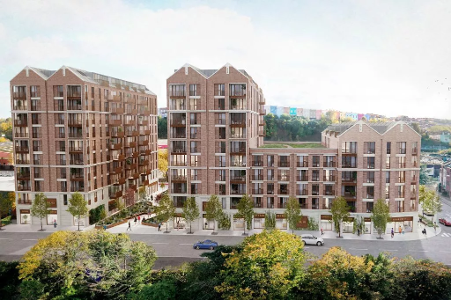
A proposed redevelopment project along Bristol’s River Avon, spearheaded by Donard (Bristol) Ltd, is facing significant financial hurdles that threaten its original scope. The site, previously occupied by the BART Spices factory, has planning for two residential tower blocks as part of a broader regeneration initiative. However, escalating costs have prompted the developer to request a reduction in the affordable housing component from 30% to 10%, according to a report submitted by property consultancy Savills to Bristol City Council on April 3, 2025. This adjustment, Donard argues, is necessary to maintain project viability amid a challenging economic landscape. Below, we examine the key factors driving these cost pressures and their implications for property developers.
Background and Project Overview
Approved by Bristol City Council’s planning committee in 2022, the development aims to transform a dormant industrial site into floats with some commercial. The original agreement stipulated that 30% of the units would be designated as affordable housing, aligning with local policy to address Bristol’s well-documented housing shortage. Since then, the site has remained undeveloped, with temporary use by van-dwellers highlighting the city’s ongoing affordability crisis. Donard’s recent submission contends that current market conditions render the initial affordable housing target unfeasible, a claim that has sparked debate over the balance between public goals and private investment.
Key Factors Impacting Construction Costs
Several economic and operational variables are contributing to the increased financial burden on this project, reflecting broader trends affecting the UK property development sector.
1. Material Cost Inflation
The price of construction materials has risen sharply in recent years, driven by global supply chain disruptions and macroeconomic pressures. Steel, concrete, and timber—essential for high-rise projects—have been particularly affected. Post-pandemic bottlenecks, compounded by geopolitical events such as the Ukraine conflict, have constrained supply. For developers, these material price hikes erode budgets established under earlier market conditions, necessitating adjustments to project scope or financing.
2. Labour Market Constraints
A shortage of skilled labour is another significant cost driver. The UK construction industry has faced a persistent decline in workforce availability, with fewer EU workers entering the market and insufficient domestic recruitment to offset the gap. Trades such as bricklaying, carpentry, and electrical work now command higher wages due to heightened demand, directly impacting labour budgets. For Donard, its likely that securing a reliable workforce at competitive rates has become a critical challenge in maintaining project timelines and profitability.
3. Energy and Operational Expenses
Elevated energy costs, lingering from Europe’s recent energy crisis, are adding further strain. Construction projects of this scale rely heavily on fuel and electricity for equipment, site operations, and worker facilities. With energy prices remaining above pre-crisis levels, operational overheads have increased, squeezing margins on fixed-cost contracts. This factor underscores the need for developers to reassess cost projections considering fluctuating utility expenses.
4. Economic and Financing Pressures
Broader inflationary trends have raised borrowing costs, as interest rates remain elevated to curb price growth. For property developers, this translates into higher financing expenses for capital-intensive projects. Donard’s reliance on external funding likely amplifies the impact of these conditions, making the original affordable housing commitment—a lower-revenue component—less tenable without compromising overall returns.
6. Implications for Developers and Policy
Donard’s request to reduce affordable housing from 30% to 10% reflects a strategic pivot to preserve financial viability. The Savills report argues that without this adjustment, the project risks stalling entirely, delivering no new housing—affordable or market-rate—to the area. This stance highlights a recurring tension in the UK property sector: reconciling local authority mandates with the economic realities of development. For Bristol, where rental prices average over £1,500 monthly and homeownership remains out of reach for many, the outcome carries significant weight.
From a business perspective, this case underscores the need for developers to build flexibility into project planning. Forward-looking cost models must account for material price volatility, labour market shifts, and energy cost fluctuations. Additionally, engaging with local authorities early to negotiate contingency measures—such as phased affordable housing delivery or public subsidies—could mitigate risks in volatile markets.
Next Steps and Industry Outlook
Bristol City Council now faces a pivotal decision: uphold the 30% affordable housing requirement, potentially jeopardising the project, or approve Donard’s revised 10% target to ensure development proceeds. The resolution, expected in the coming weeks, may influence how other UK councils address similar requests amid rising costs. For property professionals, this scenario serves as a reminder of the intricate interplay between market forces, regulatory frameworks, and social objectives—a dynamic that will continue to shape the feasibility of urban redevelopment projects in 2025 and beyond.



